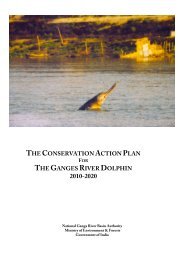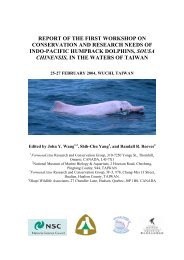Needs for additi<strong>on</strong>al research<strong>The</strong>re is a need to study local coastal populati<strong>on</strong>s<str<strong>on</strong>g>of</str<strong>on</strong>g> this species wherever it occurs in SE Asia. Boatsurveys are urgently needed. <strong>The</strong> populati<strong>on</strong>smust be assessed, <strong>and</strong> effective c<strong>on</strong>servati<strong>on</strong> plansmust be implemented, before <str<strong>on</strong>g>the</str<strong>on</strong>g> populati<strong>on</strong>sdecline to critical levels. To date, such assessment<strong>and</strong> c<strong>on</strong>servati<strong>on</strong> has taken place <strong>on</strong>ly in H<strong>on</strong>gK<strong>on</strong>g, <strong>and</strong> to a lesser extent in Xiamen. Catchesto stock oceanaria should be accurately m<strong>on</strong>itored<strong>and</strong> reported. Estimates <str<strong>on</strong>g>of</str<strong>on</strong>g> incidental mortality <strong>and</strong>abundance are particularly needed <str<strong>on</strong>g>of</str<strong>on</strong>g>f <str<strong>on</strong>g>the</str<strong>on</strong>g> westcoast <str<strong>on</strong>g>of</str<strong>on</strong>g> Taiwan, in <str<strong>on</strong>g>the</str<strong>on</strong>g> Gulf <str<strong>on</strong>g>of</str<strong>on</strong>g> T<strong>on</strong>kin nor<str<strong>on</strong>g>the</str<strong>on</strong>g>rnVietnam, <strong>and</strong> in <str<strong>on</strong>g>the</str<strong>on</strong>g> Gulf <str<strong>on</strong>g>of</str<strong>on</strong>g> Thail<strong>and</strong>. <strong>The</strong> ecologicaloverlap with fisheries should also be investigated,especially in <str<strong>on</strong>g>the</str<strong>on</strong>g> Gulf <str<strong>on</strong>g>of</str<strong>on</strong>g> Thail<strong>and</strong>.2.2.4 Grampus griseusDistributi<strong>on</strong>Wang <strong>and</strong> Chou reported that Risso’s dolphinis <str<strong>on</strong>g>the</str<strong>on</strong>g> most comm<strong>on</strong>ly encountered species <str<strong>on</strong>g>of</str<strong>on</strong>g>fHualien <strong>on</strong> <str<strong>on</strong>g>the</str<strong>on</strong>g> sou<str<strong>on</strong>g>the</str<strong>on</strong>g>astern coast <str<strong>on</strong>g>of</str<strong>on</strong>g> Taiwan. It isalso fairly comm<strong>on</strong> in <str<strong>on</strong>g>the</str<strong>on</strong>g> Bohol <strong>and</strong> Tañ<strong>on</strong> Straits,Philippines, according to Dolar.Populati<strong>on</strong>/stock structureNo new informati<strong>on</strong>.Habitat statusNo new informati<strong>on</strong>.Directed catchesWang reported that Risso’s dolphins are harpo<strong>on</strong>edin Japan <strong>and</strong> Taiwan. <strong>The</strong>re are also directed takes<str<strong>on</strong>g>of</str<strong>on</strong>g>f Palawan, Philippines, <strong>and</strong> <str<strong>on</strong>g>of</str<strong>on</strong>g>f Lamalera <strong>and</strong> Solor,Ind<strong>on</strong>esia (Rudolph <strong>and</strong> Smeenk 2002). Stocks inSE Asia may be affected by catches in Japanesewaters.By-catches<strong>The</strong>re are recent records <str<strong>on</strong>g>of</str<strong>on</strong>g> by-catch in gillnets <strong>and</strong>o<str<strong>on</strong>g>the</str<strong>on</strong>g>r types <str<strong>on</strong>g>of</str<strong>on</strong>g> nets in China (Doc. 9), <strong>and</strong> in largemeshdrift gillnets in Taiwan (Doc. 6). By-catchesalso occur in purse seines <strong>and</strong> driftnets in <str<strong>on</strong>g>the</str<strong>on</strong>g>Philippines (Doc. 19, 28).Needs for additi<strong>on</strong>al researchPopulati<strong>on</strong> studies, based <strong>on</strong> photo-identificati<strong>on</strong>,should be pursued for this species, which is wellsuitedto this research technique. Some assessment<str<strong>on</strong>g>of</str<strong>on</strong>g> <str<strong>on</strong>g>the</str<strong>on</strong>g> effects <str<strong>on</strong>g>of</str<strong>on</strong>g> by-catch in large-mesh driftnetfisheries is also needed, particularly for deepcoastal areas <str<strong>on</strong>g>of</str<strong>on</strong>g>f Taiwan <strong>and</strong> o<str<strong>on</strong>g>the</str<strong>on</strong>g>r regi<strong>on</strong>s whereRisso’s dolphins <strong>and</strong> driftnet fisheries co-occur.2.2.5 Tursiops truncatusPopulati<strong>on</strong> statusChou reported that some photo-identificati<strong>on</strong> workhad been c<strong>on</strong>ducted in Taiwan waters, <strong>and</strong> thatabout 300 individual Risso’s dolphins had beenidentified, thus providing a minimum estimate <str<strong>on</strong>g>of</str<strong>on</strong>g>populati<strong>on</strong> size (Kou 2002a). Dolar (1999a) producedan abundance estimate for <str<strong>on</strong>g>the</str<strong>on</strong>g> Sulu Sea <str<strong>on</strong>g>of</str<strong>on</strong>g> 941(CV=40%). <strong>The</strong>re are also minimum abundanceestimates for southwestern Taiwan <str<strong>on</strong>g>of</str<strong>on</strong>g> 153 dolphins(CV=77%) (Huang 1996), <strong>and</strong> nor<str<strong>on</strong>g>the</str<strong>on</strong>g>astern Taiwan<str<strong>on</strong>g>of</str<strong>on</strong>g> 218 individuals (CV=29%) (Chen 2001).Distributi<strong>on</strong><strong>The</strong>re are no c<strong>on</strong>firmed records <str<strong>on</strong>g>of</str<strong>on</strong>g> comm<strong>on</strong>bottlenose dolphins in <str<strong>on</strong>g>the</str<strong>on</strong>g> SE Asian porti<strong>on</strong> <str<strong>on</strong>g>of</str<strong>on</strong>g>Australian waters—all known bottlenose dolphinsrecords <str<strong>on</strong>g>the</str<strong>on</strong>g>re are <str<strong>on</strong>g>of</str<strong>on</strong>g> T. aduncus. However, Marshcauti<strong>on</strong>ed that <str<strong>on</strong>g>the</str<strong>on</strong>g> cetaceans in this area arepoorly studied. <strong>The</strong> Sulu Sea driftnet catches in<str<strong>on</strong>g>the</str<strong>on</strong>g> Philippines have been c<strong>on</strong>firmed to be T.truncatus, based <strong>on</strong> genetics. Wang stated thatcomm<strong>on</strong> bottlenose dolphins occur in both coastal<strong>and</strong> deepwater, <str<strong>on</strong>g>of</str<strong>on</strong>g>fshore areas <str<strong>on</strong>g>of</str<strong>on</strong>g>f Taiwan. <strong>The</strong> <strong>on</strong>lyreport <str<strong>on</strong>g>of</str<strong>on</strong>g> comm<strong>on</strong> bottlenose dolphins in Malaysiais from <str<strong>on</strong>g>the</str<strong>on</strong>g> Spratley Isl<strong>and</strong>s (Doc. 10).<str<strong>on</strong>g>Sec<strong>on</strong>d</str<strong>on</strong>g> <str<strong>on</strong>g>Workshop</str<strong>on</strong>g> <strong>on</strong> <str<strong>on</strong>g>the</str<strong>on</strong>g> <strong>Biology</strong> <strong>and</strong> C<strong>on</strong>servati<strong>on</strong> <str<strong>on</strong>g>of</str<strong>on</strong>g> Small Cetaceans <strong>and</strong> Dug<strong>on</strong>gs <str<strong>on</strong>g>of</str<strong>on</strong>g> SE Asia 71
Populati<strong>on</strong>/stock structureNo new informati<strong>on</strong>.Populati<strong>on</strong> statusComm<strong>on</strong> bottlenose dolphins occur in <str<strong>on</strong>g>the</str<strong>on</strong>g>East China Sea at an estimated density <str<strong>on</strong>g>of</str<strong>on</strong>g> 0.14individuals/km2 (Doc. 9). A minimum abundanceestimate for southwestern Taiwan is 672 dolphins(CV=44%), although this may be a combinati<strong>on</strong><str<strong>on</strong>g>of</str<strong>on</strong>g> T. truncatus <strong>and</strong> T. aduncus (Huang 1996). Apreliminary abundance estimate for nor<str<strong>on</strong>g>the</str<strong>on</strong>g>asternTaiwan is 193 individuals (CV=53%) (Chen 2001).Habitat statusHabitat in <str<strong>on</strong>g>the</str<strong>on</strong>g> Taiwan Strait is seriouslydegraded. <strong>The</strong>se animals are found entirely inside<str<strong>on</strong>g>the</str<strong>on</strong>g> 800-m depth c<strong>on</strong>tour in Philippine waters,according to Dolar.Directed catchesThis species is comm<strong>on</strong>ly taken with harpo<strong>on</strong>s inTaiwan (Doc. 6). Many Tursiops sp. (some may havebeen T. aduncus) have been live-captured in recentyears for oceanaria in China. Bottlenose dolphinsapparently are hunted for food by immigrants inSabah (Doc. 10).By-catches<strong>The</strong>re are some by-catches in trawls <strong>and</strong> purseseines in Chinese waters (Doc. 9), as well asin drift gillnets, bottom set gillnets, trammelnets, purse seines, <strong>and</strong> l<strong>on</strong>glines in Taiwan (Doc.6). Bottlenose dolphins are taken in driftnets at<str<strong>on</strong>g>the</str<strong>on</strong>g> Penghu Isl<strong>and</strong>s; however, Wang noted that itis uncertain which species <str<strong>on</strong>g>of</str<strong>on</strong>g> Tursiops is involved(likely both). <strong>The</strong>re is a str<strong>and</strong>ing record <str<strong>on</strong>g>of</str<strong>on</strong>g> aprobable by-caught specimen in H<strong>on</strong>g K<strong>on</strong>g (Doc.7). Incidental catches are also known from driftnets<strong>and</strong> purse seines in <str<strong>on</strong>g>the</str<strong>on</strong>g> Philippines (Doc. 19, 28).Needs for additi<strong>on</strong>al researchMore genetic studies are needed to determinewhich <str<strong>on</strong>g>of</str<strong>on</strong>g> <str<strong>on</strong>g>the</str<strong>on</strong>g> two species <str<strong>on</strong>g>of</str<strong>on</strong>g> Tursiops are involvedin sightings <strong>and</strong> catches throughout differentareas <str<strong>on</strong>g>of</str<strong>on</strong>g> SE Asia. <str<strong>on</strong>g>Workshop</str<strong>on</strong>g> participants noted<str<strong>on</strong>g>the</str<strong>on</strong>g> difficulties in distinguishing between <str<strong>on</strong>g>the</str<strong>on</strong>g> twospecies in <str<strong>on</strong>g>the</str<strong>on</strong>g> field <strong>and</strong> urged that identificati<strong>on</strong>sbe c<strong>on</strong>sidered tentative in <str<strong>on</strong>g>the</str<strong>on</strong>g> absence <str<strong>on</strong>g>of</str<strong>on</strong>g>specimens, genetic samples or o<str<strong>on</strong>g>the</str<strong>on</strong>g>r vouchermaterial. Investigati<strong>on</strong>s <str<strong>on</strong>g>of</str<strong>on</strong>g> by-catch, especially inInd<strong>on</strong>esia, <str<strong>on</strong>g>the</str<strong>on</strong>g> Philippines, <strong>and</strong> Taiwan, are als<strong>on</strong>eeded for this species.2.2.6 Tursiops aduncusDistributi<strong>on</strong><strong>The</strong> Indo-Pacific bottlenose dolphin appears tohave a fragmented distributi<strong>on</strong>. It occurs in SharkBay (Western Australia), Hervey Bay (easternAustralia), <strong>and</strong> o<str<strong>on</strong>g>the</str<strong>on</strong>g>r tropical areas <str<strong>on</strong>g>of</str<strong>on</strong>g> nor<str<strong>on</strong>g>the</str<strong>on</strong>g>rnAustralia. <strong>The</strong>re are no c<strong>on</strong>firmed records <str<strong>on</strong>g>of</str<strong>on</strong>g> T.aduncus anywhere in <str<strong>on</strong>g>the</str<strong>on</strong>g> Philippines, although<str<strong>on</strong>g>the</str<strong>on</strong>g> possibility <str<strong>on</strong>g>of</str<strong>on</strong>g> <str<strong>on</strong>g>the</str<strong>on</strong>g>ir occurrence has not beenruled out. Chantrapornsyl reported that all knownbottlenose dolphins from <str<strong>on</strong>g>the</str<strong>on</strong>g> Gulf <str<strong>on</strong>g>of</str<strong>on</strong>g> Thail<strong>and</strong> are<str<strong>on</strong>g>of</str<strong>on</strong>g> <str<strong>on</strong>g>the</str<strong>on</strong>g> aduncus species, <strong>and</strong> bottlenose dolphinsrecently observed in Cambodian waters (Doc.34) will probably prove to be this species. InTaiwan, T. aduncus appear to occur in shallowwater(c<strong>on</strong>tinental-shelf) areas, especially whererocky reefs are present, such as at Nan Wan at <str<strong>on</strong>g>the</str<strong>on</strong>g>sou<str<strong>on</strong>g>the</str<strong>on</strong>g>rn tip <str<strong>on</strong>g>of</str<strong>on</strong>g> <str<strong>on</strong>g>the</str<strong>on</strong>g> isl<strong>and</strong> <strong>and</strong> <str<strong>on</strong>g>the</str<strong>on</strong>g> Penghu Isl<strong>and</strong>s(Doc. 8).Populati<strong>on</strong>/stock structure<strong>The</strong>re is good reas<strong>on</strong> to believe that <str<strong>on</strong>g>the</str<strong>on</strong>g> sou<str<strong>on</strong>g>the</str<strong>on</strong>g>rnTaiwan group is a functi<strong>on</strong>al or family unit that isisolated from o<str<strong>on</strong>g>the</str<strong>on</strong>g>rs for at least part <str<strong>on</strong>g>of</str<strong>on</strong>g> <str<strong>on</strong>g>the</str<strong>on</strong>g> year(Doc. 8).Populati<strong>on</strong> statusA density estimate is available for <str<strong>on</strong>g>the</str<strong>on</strong>g> westernTaiwan Strait, between Xiamen <strong>and</strong> D<strong>on</strong>gshan(0.044 individuals/km 2 ), but <str<strong>on</strong>g>the</str<strong>on</strong>g> overall populati<strong>on</strong>size is not known (Doc. 9). <strong>The</strong> sou<str<strong>on</strong>g>the</str<strong>on</strong>g>rn Taiwanpopulati<strong>on</strong> appears be very small, possibly <strong>on</strong>ly72 CMS Technical Series Publicati<strong>on</strong> Nº 9 - 2005
- Page 1 and 2:
CMS Technical Series Publication N
- Page 3 and 4:
Published by the U
- Page 5 and 6:
TABLE OF CONTENTSpage1. Preliminari
- Page 7 and 8:
AppendicesAppendix 1 - List <strong
- Page 9 and 10:
8 CMS Technical Series Publication
- Page 11 and 12:
10 CMS Technical Series Publication
- Page 13 and 14:
The cetacean species reviewed inclu
- Page 15 and 16:
Table 1. Major commercial Commonwea
- Page 17 and 18:
(2) State Legislation.In state wate
- Page 19 and 20:
(2) Identification of</stro
- Page 21 and 22: Coastal speciesThe most frequently
- Page 23 and 24: Coastal speciesThere are currently
- Page 25 and 26: and Guangxi Provinces (Yang et al.
- Page 27 and 28: Table 3. Records of</strong
- Page 29 and 30: can be viewed as the</stron
- Page 31 and 32: Workshop participa
- Page 33 and 34: ioaccumulation have not yet been ex
- Page 35 and 36: of fishermen who h
- Page 37 and 38: are supplied to scholars and organi
- Page 39 and 40: threats. Many marine mammal populat
- Page 42: waters or recognize important inter
- Page 47 and 48: James Cook University (Queensland,
- Page 49 and 50: the last ten years
- Page 51 and 52: proactive in engaging more staff an
- Page 53 and 54: of SE Asia. Two sp
- Page 55 and 56: San Francisco (Negros Oriental); Li
- Page 57 and 58: Legal status and present management
- Page 59 and 60: within 15 kilometers from t
- Page 61 and 62: US, has actively participated in ce
- Page 63 and 64: the project was su
- Page 65 and 66: Recently, the camp
- Page 67 and 68: Mekong River downstream of<
- Page 69 and 70: porpoises in tropical waters <stron
- Page 71: species in the Ind
- Page 75 and 76: Needs for additional researchStock
- Page 77 and 78: waters of SE Asia,
- Page 79 and 80: caused mortality is certainly large
- Page 81 and 82: Needs for additional researchProper
- Page 83 and 84: from SE Asia, it is known to occur
- Page 85 and 86: 3.1.7 AustraliaDugongs occur all al
- Page 87 and 88: Table 8. Conservation objectives id
- Page 89 and 90: 3) Monitoring and assessment <stron
- Page 91 and 92: Table 10. Outline of</stron
- Page 93 and 94: The group agreed that this set <str
- Page 95 and 96: 6. SUMMARY AND CONCLUSIONSThe works
- Page 97 and 98: 96 CMS Technical Series Publication
- Page 99 and 100: Bank, E. 1931. A popular account <s
- Page 101 and 102: Dalebout, M. L., J. G. Mead, C. Sco
- Page 103 and 104: Jaaman, S. A., E. Tangon, I. Isnain
- Page 105 and 106: Lin, Y.-J. 1997. Mitochondrial DNA
- Page 107 and 108: Smith, B.D., T. A. Jefferson, D. Ho
- Page 109 and 110: Yang, W.-C. 2000. Morbillivirus inf
- Page 111 and 112: CHOU Lien-SiangDepartment o
- Page 113 and 114: Brian D. SMITHWildlife Conservation
- Page 115 and 116: APPENDIX 3Agenda1. Preliminaries2.
- Page 117 and 118: Doc. 22 Dugong conservation activit
- Page 119 and 120: AreaDatesSurveyTypeEffortSpeciesNo.
- Page 121 and 122: AreaDatesSurveyTypeEffortSpeciesNo.
- Page 123 and 124:
AreaDatesSurveyTypeEffortSpeciesNo.
- Page 125 and 126:
Phase ofActionPlan
- Page 127 and 128:
[Small cetaceans are defined to inc
- Page 129 and 130:
f) recognizing that by-catch in fis
- Page 131 and 132:
130 CMS Technical Series Publicatio
- Page 133 and 134:
APPENDIX 9Abstracts of</str
- Page 135 and 136:
The (IUCN Critically Endangered) Du
- Page 137 and 138:
Status of
- Page 139 and 140:
Cetacean Habitats in the</s
- Page 141 and 142:
Conservation of <s
- Page 143 and 144:
Summary of Current
- Page 145 and 146:
Indonesia’s Cetacean Migration Co
- Page 147 and 148:
Conservation Effort to Protect <str
- Page 149 and 150:
The Status of <str
- Page 151 and 152:
Can the Developing
- Page 153 and 154:
Status and Conservation of<
- Page 155 and 156:
Legal Hunting of C
- Page 157 and 158:
Indo-Pacific Bottlenose Dolphins (T
- Page 159 and 160:
Feasibility Study of</stron
- Page 161 and 162:
Songs of a Humpbac





